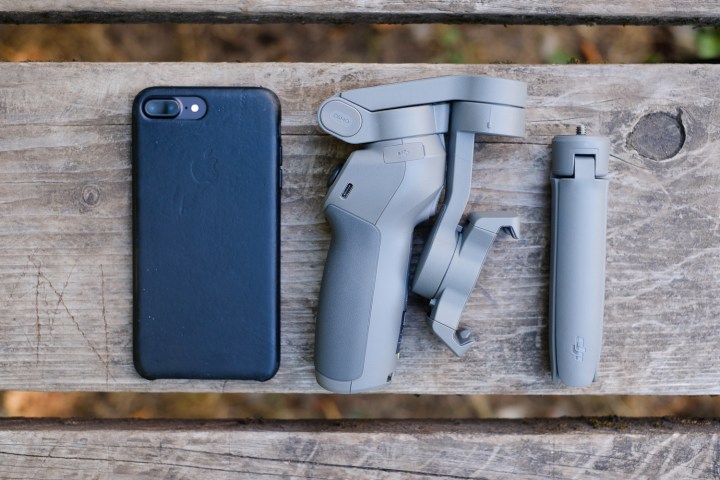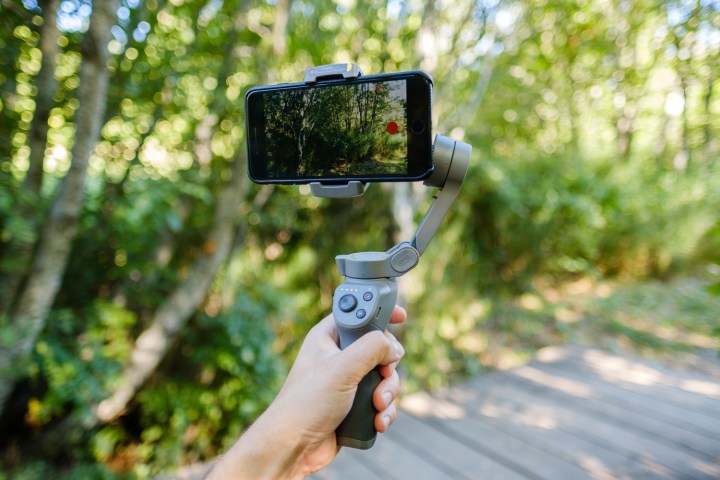“Better, easier, and more affordable than before, the Osmo Mobile 3 is as slick and smooth as can be.”
- Compact, foldable design
- New Sport and Story modes
- Active Track 3.0 with gesture control
- Fast portrait/landscape orientation switching
- Lacks some advanced settings
- Some key features are iOS-only
The camera in your phone is pretty good, and even capable of shooting 4K video. But one of the biggest challenges in getting professional results from your phone is camera movement. Shaky handheld footage just isn’t going to cut it. Enter the DJI Osmo Mobile 3, a lightweight handheld gimbal that creates perfectly smooth shots and can even track subjects.
DJI has continued to refine its approach to the phone gimbal. It is more flexible, easier to use, and even cheaper than the Osmo Mobile 2. With its foolproof Bluetooth connection, effortless switching between portrait and landscape orientation, and new shooting modes, it is a worthy replacement to its predecessor and a new benchmark for the category.
When folded, the entire device isn’t much taller than a plus-sized phone.
But while the new Osmo’s hardware approaches perfection, the accompanying DJI Mimo app leaves out some advanced features — especially for Android users. Hopefully this can be remedied in a software update. Even so, its low price tag of $119 makes it hard to pass up.
Design and handling
While the matte gray color and basic appearance of the Osmo Mobile 3 look similar to the previous version, a closer investigation reveals several small changes. The grip is now tilted 15 degrees forward and a trigger button has been added to the front that can be used to quickly recenter the gimbal, activate subject tracking, or switch between the front and rear cameras on your phone.

Mounting and balancing your phone is easy and perfect balance, while helpful, isn’t required. The gimbal’s motors are strong enough to correct for improper balance, making this the quickest gimbal to set up that I’ve ever used.
Switching between portrait and landscape orientation is faster than ever thanks to the “quick roll” feature. Unlike the Osmo Mobile 2, you no longer have to adjust the position of the phone when switching orientations. You can even do it while recording.
The entire gimbal folds, collapsing against the handle. When folded, the device isn’t much taller than a plus-sized phone. Even when extended, the Osmo Mobile 3 stands a few millimeters shorter than its forebear. It’s also about 3 ounces lighter — not a huge difference, but it’s nice that the extra articulation hasn’t increased weight.

The foldable design makes the Osmo Mobile 3 much easy to transport, and it tucks neatly into a carrying case alongside a tabletop tripod that’s part of the $139 Combo pack (tested). The tripod is a nearly essential piece of the kit, so I’d opt for the Combo pack. However, the handle uses a standard 1/4-inch socket, so you can mount it to virtually any other tripod.
The battery is integrated into the device and charges via USB-C. DJI advertises 15 hours of battery life, which will easily outlast your phone. There’s also a USB-A port that can be used to power your phone while attached to the gimbal.
Features and performance
The Osmo Mobile 3 is tied together with excellent software. If you’re upgrading from a previous Osmo gimbal, note that you’ll no longer use the DJI Go app. Instead, you’ll need the DJI Mimo app. This is where you’ll connect, calibrate, and control the gimbal.
Thanks to Bluetooth LE, connecting the gimbal to the app is a two-tap process that couldn’t be easier. You’ll never have to repeat the connection process again unless you want to pair a new phone.
You should run auto-calibration every time you attach your phone. This will correct for drift that can result from the gimbal being slightly off balance. I found that anytime the gimbal’s performance seemed off, re-calibrating fixed the issue.
The app serves up several shooting modes, including photo, panorama, video, slow motion, and hyper-lapse. There’s also Sport mode, which increases the response time and speed of the gimbal motors, and Active Track 3.0, the latest version of DJI’s artificial intelligence-based subject tracking.
A new gesture control feature works in combination with Active Track to take hands-free shooting to the next level. Hold up your hand to start a countdown timer, and the gimbal automatically moves to center your face in the frame. This is great for selfies or group photos, and even more impressive in video, where the gimbal will continue to track you as you move around.

In my testing, tracking worked well so long my face remained clearly in the frame. When I turned away, it stopped tracking. I found this to be true using both the front and rear cameras, though DJI says it uses “head and shoulders” tracking on the rear camera that should keep tracking you even when your back is turned. Bad lighting can also cause it to fail; I walked in front of a bright window and it lost me entirely. Still, this could be a big feature for vloggers, YouTubers, or anyone who needs hands-free video.
Another interesting, if not yet fully realized, feature is the new Story mode. This serves up a collection of templates for shooting and editing short clips together with transitions built from a mixture of gimbal movement and digital effects. In its current state, Story mode leaves much to be desired in terms of flexibility — you can’t change the length of any theme, or edit the text on themes that have titles — but there’s potential. For now, it’s an easy to way to create a slick intro sequence for your travel vlog.
Advanced settings are lacking
I do have complaints about odd limitations in the Mimo app. Many people won’t notice them, but experienced video editors will find the rough edges.
While the app does offer full manual exposure control if you want it, it does not let you shoot at 24 frames per second. That’s not a deal breaker for the average customer, but videographers and filmmakers will certainly miss it. You can use a different app, like Filmic Pro, if you want more advanced control — but you’ll miss out on DJI-specific features like Active Track if you do.
You also can’t fine-tune the speed of the motors as you can on DJI’s higher-end gimbals. I found I preferred shooting in Sport mode even with non-sporty subjects, as the slower response in default mode can feel lethargic. It’s fine for slow, sweeping shots, but even a casual hike warrants using Sport mode. The slow motion feature, meanwhile, is very slow, recording a 720p video that plays back at 1/8 speed. A brief 5-second shot suddenly becomes 40 seconds long, and there are no options for other speeds.
Also, some key features are iOS-only, at least for now. Android users miss out on exposure adjustments, including basic exposure compensation, and slow motion. Again, you could use another app for those features, but that’s not ideal. With all the different Android phones out there, it’s probably more difficult for DJI to make an app that can properly take advantage of them, but I hope some of these problems can be solved in the future.
Our take
For beginners and casual videographers, the DJI Osmo Mobile 3 is a must-have accessory. Its smart design, strong feature set, and fair price make it stand out from the crowd. It is both powerful and easy to use, and the difference it makes in the quality of your footage can be staggering.
Is there a better alternative?
No. As with drones, DJI sets the pace for gimbals and others will follow.
How long will it last?
Compared to DJI’s higher-end Ronin line, the Osmo Mobile 3 is not as robust, a sacrifice to hit its $119 price. Yet it still feels well made and should hold up to normal wear and tear for years.
The Osmo Mobile 2 stuck around for a little over a year before version 3 was announced. Even so, the Osmo Mobile 2 remains a useful gimbal that could soldier on for several years. We expect the same longevity from the Osmo Mobile 3.
Should you buy it?
Yes. If you shoot a lot of video on your phone, nothing will help you get the professional look more than a good gimbal. The DJI Osmo Mobile 3 is the best I’ve seen.





